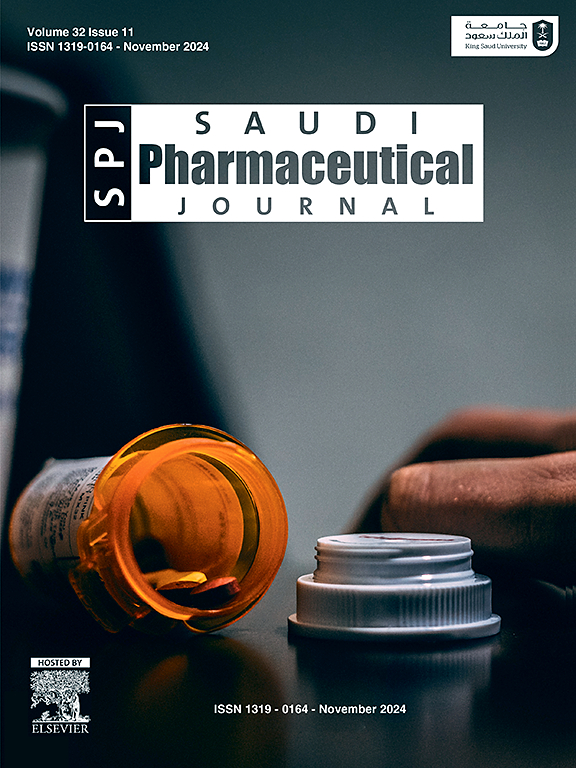Pharmaceutical quality of dispersible diclofenac tablets in the Saudi market
IF 3.4
3区 医学
Q2 PHARMACOLOGY & PHARMACY
引用次数: 0
Abstract
The fundamental objective in developing any drug delivery approach is to achieve effective and safe therapy. Medications classified as generics are those that contain the same active ingredients and have the same quality as the reference medications. Several generic drugs are available on the market, all at a reasonable cost. In this study, the quality of Three generic brands of diclofenac dispersible tablets available in the Saudi market was assessed, namely: G1 and G2, and G3.
Except for the borderline performance of one generic formulation (G3), all formulations passed in vitro quality tests according to the United States Pharmacopoeia. According to the US Pharmacopoeia, every generic formulation passed in vitro quality tests, except for one generic formulation (G3) that performed inconclusively. All brands showed low weight variation, minimum weight loss in the friability test, and a rapid dispersion time of around 5 s. The chemical potency results demonstrated that all three brands complied with United States Pharmacopeia (USP) specifications, typically falling between 90% and 110% of the labeled amount. G1 and G2 passed the content uniformity test in their first attempt. G3 initially failed the content uniformity test but passed upon retesting with additional samples. G1 and G2 tablets passed the USP Acceptance criteria in stage one, and G3 tablets met the requirements in stage two. G1 showed the highest DE (%78.83), followed by G2 (%72.23), and G3 (%67.50). The G1 dissolution data, which showed the highest dissolution efficiency, were used as the reference product to calculate the similarity factor (f2 (ratio. G1 (Reference) and G2 with an f2 of (58.3) have similar dissolution profiles, however, the dissolution profiles for the two products may be considered similar without f2 calculation since more than 85% of the drug was dissolved within 15 min (SFDA Guidelines for Bioequivalence, Similarity while G3, with an f2 of (47.5) suggest a lack of similarity between the two dissolution profiles. This study highlights the importance of post-marketing evaluations of generic drug performance.
沙特市场双氯芬酸分散片的药品质量
开发任何给药方法的基本目标都是实现有效和安全的治疗。被归类为仿制药的药物是指那些含有与参考药物相同的有效成分并具有相同质量的药物。市场上有几种仿制药,价格都很合理。本研究对沙特市场上销售的三种双氯芬酸分散片的质量进行了评价,分别是:G1、G2和G3。除了一个仿制制剂(G3)的临界性能外,所有制剂都通过了根据美国药典进行的体外质量测试。根据美国药典,每个仿制制剂都通过了体外质量测试,除了一个仿制制剂(G3)表现不确定。所有品牌均表现出较低的重量变化,易碎性试验中重量损失最小,分散时间在5 s左右。化学效力结果表明,所有三个品牌都符合美国药典(USP)规范,通常在标签量的90%至110%之间。G1和G2第一次尝试通过了内容均匀性测试。G3最初的含量均匀性测试不合格,但在补充样品后重新测试合格。G1、G2片通过第一阶段USP验收标准,G3片符合第二阶段要求。G1组DE最高(%78.83),其次为G2 (%72.23), G3(%67.50)。以溶出效率最高的G1溶出度数据作为参比,计算相似因子(f2)比。G1(参考文献)和G2 (f2为(58.3))具有相似的溶出度特征,然而,由于超过85%的药物在15分钟内溶解(SFDA生物等效性指南,相似性),因此在不计算f2的情况下,两种产品的溶出度特征可以被认为相似(SFDA生物等效性指南,相似性),而G3 (f2为(47.5))表明两种产品的溶出度特征缺乏相似性。本研究强调了仿制药上市后性能评价的重要性。
本文章由计算机程序翻译,如有差异,请以英文原文为准。
求助全文
约1分钟内获得全文
求助全文
来源期刊

Saudi Pharmaceutical Journal
PHARMACOLOGY & PHARMACY-
CiteScore
6.10
自引率
2.40%
发文量
194
审稿时长
67 days
期刊介绍:
The Saudi Pharmaceutical Journal (SPJ) is the official journal of the Saudi Pharmaceutical Society (SPS) publishing high quality clinically oriented submissions which encompass the various disciplines of pharmaceutical sciences and related subjects. SPJ publishes 8 issues per year by the Saudi Pharmaceutical Society, with the cooperation of the College of Pharmacy, King Saud University.
 求助内容:
求助内容: 应助结果提醒方式:
应助结果提醒方式:


